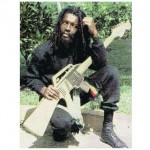BY BALFORD HENRY—


BEHIND every successful man there’s a woman. In Peter Tosh’s case it was Marlene Brown.
Since Tosh’s death at his St Andrew home in September 1987, she has travelled a long road to get recognition for his success as a solo artist after leaving The Wailers, as well as getting industry investors to recognize the value of his heritage.
That all seems to be coming together on Tosh’s birthday (October 19), a museum has opened at Pulse’s headquarters on Trafalgar Road in St Andrew. During the 1980’s Brown was not only his partner, but his confidante.
“It was my idea to have the museum set up,” she insisted, recalling how determined she was to protect Tosh’s legacy, despite being ignored by his family, friends and his estate.
“I toyed with this idea for 28 years. I said to myself, ‘Marlene, you have all these artefacts for Peter; why don’t you have a museum set up for him in Kingston?’ But, I couldn’t afford it and I couldn’t get the right people to work with,” she told the Jamaica Observer.
“A lot of people told me they were interested, but I knew they weren’t right for the project, so I waited on the right person to approach me,” she said.

That “right person” turned out to be Pulse’s chairman, Kingsley Cooper.
She said that she had no problem working with Cooper, whom she grew up with in east Kingston.
Cooper had a long relationship with Tosh dating back to his last concert performance at Pulse’s Superjam in 1983.
“We hold the rights to the video of that last concert and have worked hard with Peter’s estate and other connections over several years to make the museum happen,” said Cooper.
“In that regard, we have been entrusted with significant responsibility, including the preservation of these artefacts,” he added.
Brown was with Tosh the night he was gunned down. Radio broadcaster Jeff ‘Free I’ Dixon and Wilton Brown were also killed. She was shot in the head but survived by playing dead.
Days later, Brown walked out of the hospital where she had been admitted for treatment, without being discharged, and her head still bandaged.
She headed for her home in Barbican, where she organized the safe keeping of the most valuable items she and Tosh had stored there. She then headed for New York, intending to collect the rest of their valuables which were at an apartment in Manhattan which they shared half of each year.

However, by the time she reached there a Tosh relative had already taken charge, and the police prevented her from taking anything from the apartment except for a few pieces of her clothing.
Brown was furious because she felt that she was being locked out of her home and unable to access her possessions.
She returned home and packed away those she had extracted from the Barbican home.
Since then she has waited 29 years without any income from Tosh’s estate, hoping that one day she would be able to have them placed in a museum in his honor.

Brown, 55, leads a very remote life in East Rural St Andrew. She earns from use of the items she has loaned to the museum, including Tosh’s M16 guitar and his famous unicycle.
She dreams of one day filling her hilly terrain home with not only Tosh’s music, but also voices of thousands of visitors reliving his story.

You must log in to post a comment.